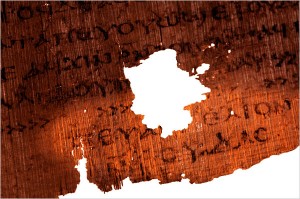Nestle-Aland 28 Has Appeared
by larryhurtado
Last Friday I gratefully received a copy of the 28th edition of the Nestle-Aland Novum Testamentum Graecae. For the moment, other pressing duties (including writing a slew of reference letters for former PhD students) prevent me from much more than a quick persusal of the Introduction. But anytime there is a new Nestle-Aland, it’s news for NT scholars (and especially textual-critic geeks such me). So, for now, a brief notice of some of the things new in this edition.
The major change is that the text of the Catholic Epistles reflects the textual decisions arising from the Editio Critica Maior (ECM) project, based in the Muenster Institute for Text-Critical Research. Thus far, the ECM project has completed work on the Catholic Epistles only, aiming to complete the rest of the NT over the next decade or so. So, for this edition, the rest of the NT remains essentially the text found in the 27th edition of Nestle-Aland.
Compared to N-A 27, there are different variants preferred at the following locations in the Catholic Epistles: James 1:20; 2:3, 4, 15; 4:10 (now preferring μερει); 1 Peter 1:6, 16; 2:5, 25; 4:16; 5:1, 9, 10; 2 Peter 2:6, 11, 15, 18, 20; 3:6, 10 (preferring ουξ ευρεθησεται), 16, 18; 1 John 1:7; 3:7; 5:10, 18; 2 John 5, 12; 3 John 4; Jude 5 (preferring Ιησους), 18.
But this 28th edition also reflects a number of other changes, especially in the textual apparatus and related matters. The apparatus has been “rearranged . . . for more tightness and clarity,” and it does have a less cramped look, making it markedly easier to read. (Now, if only NT scholars more widely would learn to do so!) Here are some further changes:
All manuscripts cited “consistently” in a given NT writing will be listed for all variation-units, whatever variant they support, producing a “positive” apparatus. So, if a given manuscript doesn’t appear in a given variation-unit, it means that at that point either there is a lacuna or it is illegible.
Conjectures are no longer cited in the apparatus, the editors judging that citation without bibliographical reference to where the conjecture was offered is “unsatisfactory”. (An index of all conjectures in previous N-A editions has been produced by the “New Testament Conjectoral Emendation” project at the Free University, Amsterdam.)
Latin abbreviations used in the apparatus “are kept as simple as possible” and a list of translations of them appears in Appendix IV.
The numerous cross-references in the outer margins have been “thoroughly revised”.













